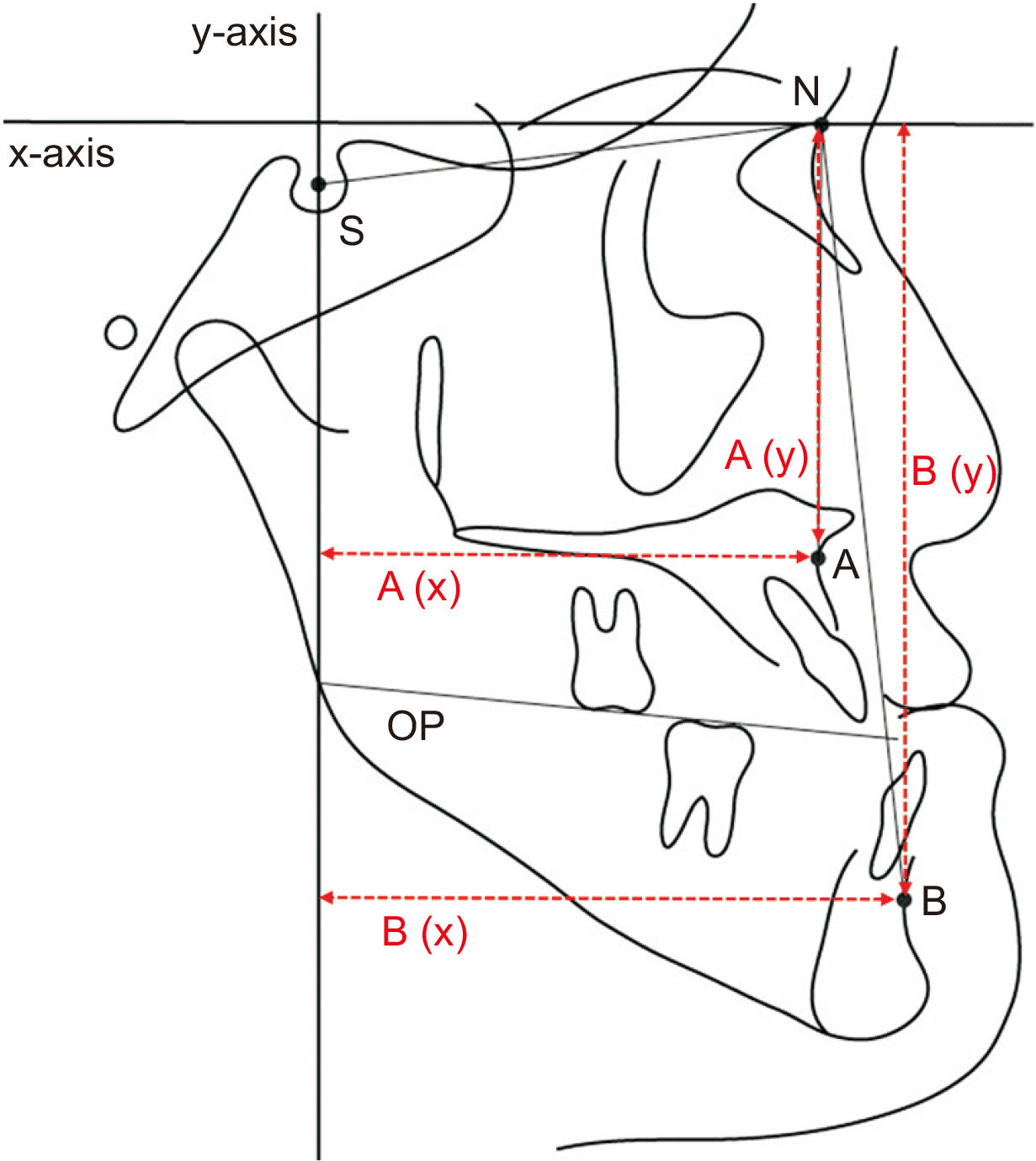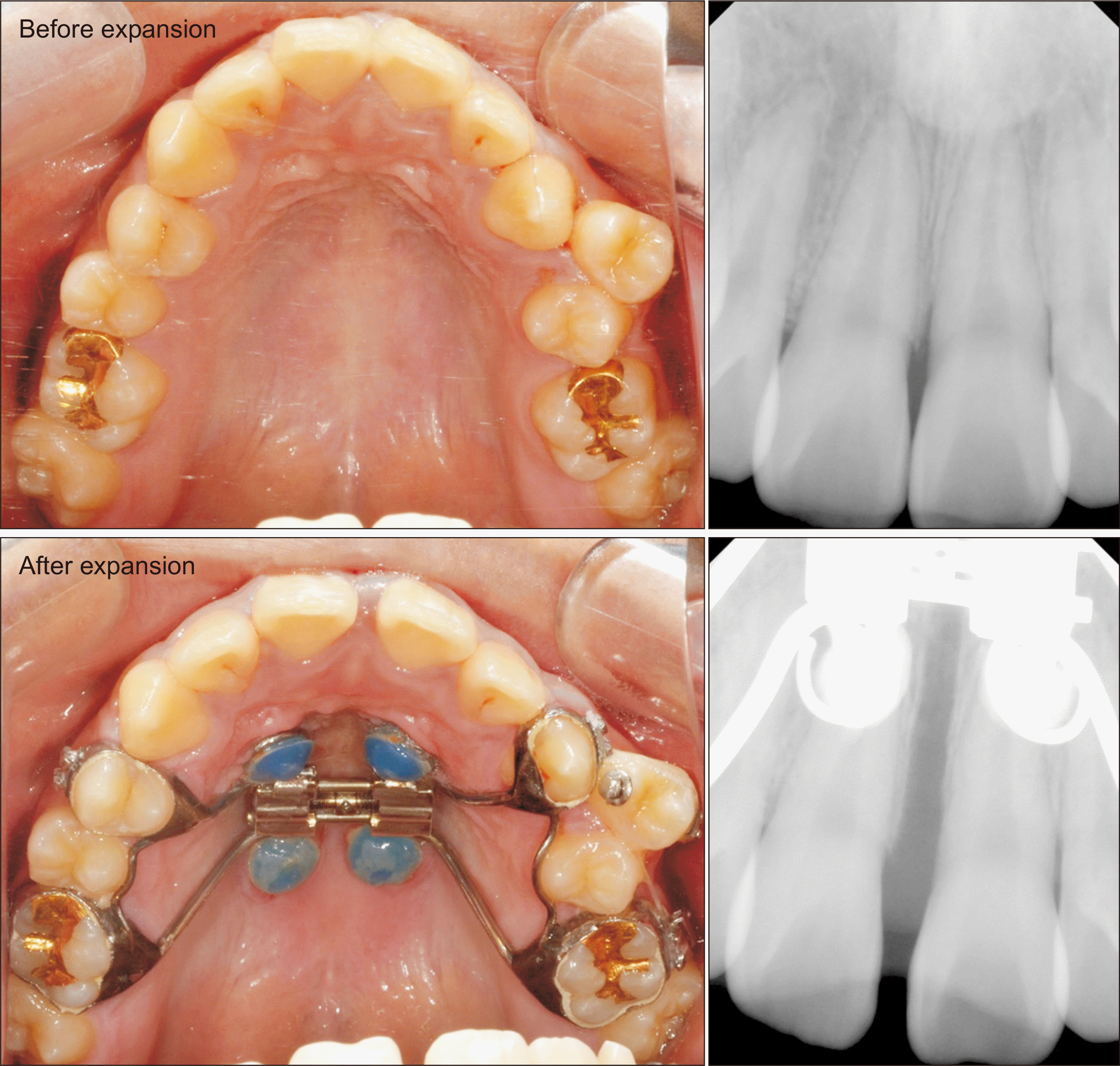INTRODUCTION
MATERIALS AND METHODS
Study design and patients
Orthognathic treatment
Dental cast analysis
Lateral cephalometric analysis
 | Figure 2Lateral cephalometric analysis performed to evaluate skeletal changes after bimaxillary surgery with or without presurgical miniscrew-assisted rapid palatal expansion. The x-axis is the horizontal plane that shifts the SN plane up 7° relative to N. The y-axis is the plane through S and perpendicular to the x-axis.
A, Point A; A (x), horizontal position of point A; A (y), vertical position of point A; B, point B; B (x), horizontal position of point B; B (y), vertical position of point B; N, nasion; OP, occlusal plane; S, sella.
|
Reliability
Statistical analysis
RESULTS
Table 1
| Variable | Control (n = 20) | MARPE (n = 20) | p-value |
|---|---|---|---|
| Sex | 1.000† | ||
| Male | 10 (50.0) | 9 (45.0) | |
| Female | 10 (50.0) | 11 (55.0) | |
| Age (yr) | 21.1 ± 2.6 | 21.2 ± 2.9 | 0.925‡ |
| Maxillomandibular arch width difference (mm) | |||
| ICW difference | 8.0 ± 2.0 | 6.7 ± 2.6 | 0.089§ |
| IPMW difference | 8.0 ± 2.4 | 7.4 ± 3.8 | 0.608§ |
| IMW difference | 6.2 ± 2.3 | 3.1 ± 2.1 | < 0.001§ |
Table 2
| Variable | Control group | MARPE group | p-value |
|---|---|---|---|
| MxICW (mm) | 0.4 ± 1.5 | 2.7 ± 2.1 | < 0.001 |
| MxIPMW (mm) | 0.2 ± 1.2 | 3.6 ± 2.4 | < 0.001 |
| MxIMW (mm) | −0.6 ± 1.2 | 2.0 ± 1.3 | < 0.001 |
Table 3
MARPE, Miniscrew-assisted rapid palatal expansion; SNA, angle formed by the lines connecting sella, nasion, and point A; SNB, angle formed by the lines connecting sella, nasion, and point B; SN-OP, angle between the sella–nasion plane and the occlusal plane; A (x), horizontal position of point A; B (x), horizontal position of point B; A (y), vertical position of point A; B (y), vertical position of point B; T1, 1 month before surgery; T2, 2 days after surgery; T3, 6 months after surgery.
Table 4
Group comparisons were tested using the independent t-test with Bonferroni correction (p < 0.05/3). Positive and negative values indicate, respectively, the anterior and posterior horizontal changes, inferior and superior vertical changes, and increased and decreased dimensional changes.
T1, 1 month before surgery; T2, 2 days after surgery; MARPE, miniscrew-assisted rapid palatal expansion; SNA, angle formed by the lines connecting the sella, nasion, and point A; SNB, angle formed by the lines connecting the sella, nasion, and point B; SN-OP, angle between the sella–nasion plane and the occlusal plane; A (x), horizontal position of point A; B (x), horizontal position of point B; A (y), vertical position of point A; B (y), vertical position of point B.
Table 5
Group comparisons were tested using the independent t-test with Bonferroni correction (p < 0.05/3). The positive and negative values indicate, respectively, the anterior and posterior horizontal changes, inferior and superior vertical changes, and increased and decreased dimensional changes.
T2, 2 days after surgery; T3, 6 months after surgery; MARPE, miniscrew-assisted rapid palatal expansion; SNA, angle formed by the lines connecting the sella, nasion, and point A; SNB, angle formed by the lines connecting the sella, nasion, and point B; SN-OP, angle between the sella-nasion plane and the occlusal plane; A (x), horizontal position of point A; B (x), horizontal position of point B; A (y), vertical position of point A; B (y), vertical position of point B.
Table 6
T0, Before presurgical orthodontics; T1, 1 month before surgery; T2, 2 days after surgery; T3, 6 months after surgery; MARPE, miniscrew-assisted rapid palatal expansion; B (x), horizontal position of point B; B (y), vertical position of point B; r, Pearson’s correlation coefficient; MxICW, maxillary intercanine width; MxIPMW, maxillary interpremolar width; MxIMW, maxillary intermolar width.




 PDF
PDF Citation
Citation Print
Print




 XML Download
XML Download